page 106

©TZIDO SUN/SHUTTERSTOCK.COM RF
page 107
LO4.1
Identify commonly used financial services.
Planning Your Use of Financial Services
In recent years, banking activities have changed:
from standing in line for a teller...to using a smartphone app.
from writing a check...to transmitting money with a mobile payment system.
from sending in a deposit by mail...to clicking a picture for a remote check deposit.
from obtaining a loan from a bank...to borrowing from a peer-to-peer lender.
While many alternative service providers are available, banks, savings and loan associations, credit unions, and other financial institutions process most payment, savings, and credit transactions. Exhibit 4–1 is an overview of financial services and institutions for managing cash flows and moving toward financial goals.
Exhibit 4–1 Financial Institutions and Banking Services
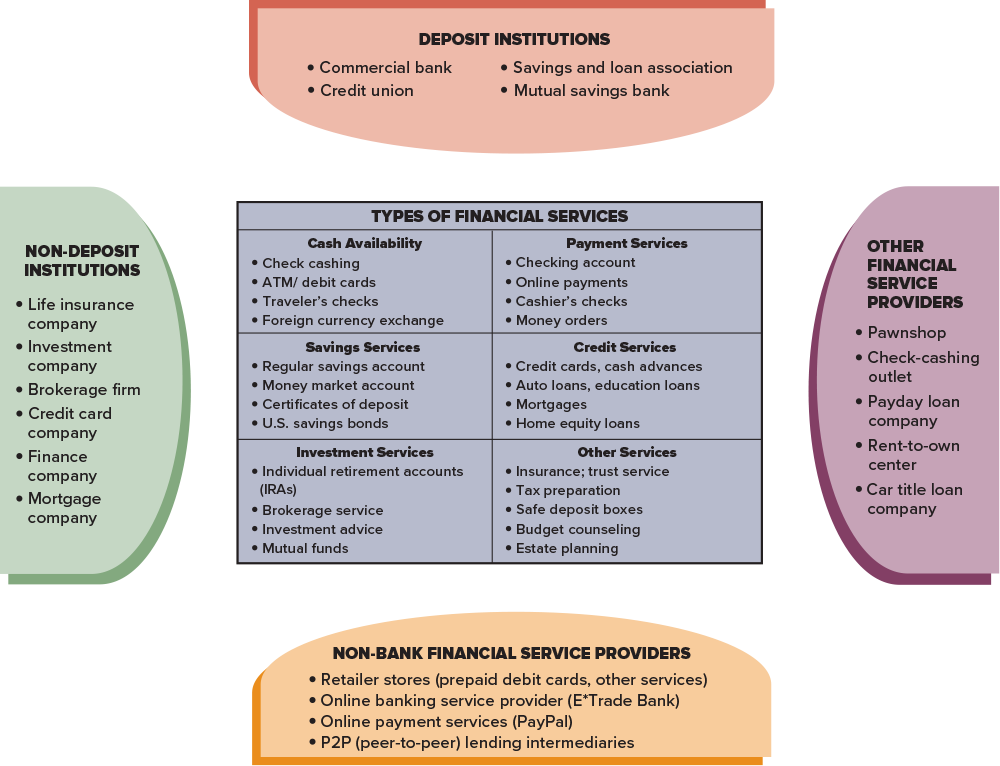
Managing Daily Money Needs
Buying groceries, paying the rent, and completing other routine spending activities involve a cash management plan. Cash, check, credit card, debit card, and online/mobile transfer are the common payment choices. Frequent mistakes when managing current cash needs include (1) overspending due to impulse buying and overusing credit; (2) having insufficient liquid assets to pay current bills; (3) using savings or borrowing to pay for current expenses; and (4) failing to place funds not needed for current expenses in a savings account or investment plan.
page 108
Sources of Quick Cash
No matter how carefully you manage your money, at some time you will need more cash than you have available. To cope in that situation, you have two basic choices: liquidate savings or borrow. A savings account, certificate of deposit, mutual fund, or other investment may be accessed when you need funds. Or a credit card cash advance or a personal loan may be appropriate. Remember, however, that both using savings and increasing borrowing reduce your net worth and your potential to achieve long-term financial security.
Types of Financial Services
Banks and other financial institutions offer services to meet your needs for achieving financial goals. These services may be viewed in four categories:
Savings provides safe storage of funds for future use. Commonly referred to as time deposits, money in savings accounts and certificates of deposit are examples of savings plans.
Payment services allow you to transfer money to pay expenses and for other daily business activities. Checking accounts and other payment methods are generally called demand deposits.
Borrowing is used by most people at some time during their lives. Credit alternatives range from short-term accounts, such as credit cards and cash loans, to long-term borrowing, such as a home mortgage.
page 109Other financial services include insurance, investments, tax assistance, and financial planning. A trust is a legal agreement that provides for the management and control of assets by one party for the benefit of another. This type of arrangement is usually created through a commercial bank or a lawyer. Parents who want to set aside certain funds for their children’s education may use a trust.
To simplify financial services, many financial businesses offer consolidated accounts. An asset management account, also called a cash management account, provides a complete financial services program for a single fee. Investment companies and others offer this type of account, with checking, an ATM card, a credit card, online banking, and a line of credit as well as access for buying stocks, bonds, mutual funds, and other investments.
Online and Mobile Banking
Banking online and through wireless mobile systems allow for all types of financial services (see Exhibit 4–2). While most traditional financial institutions offer online banking services, web-only banks also exist. For example, E*Trade Bank operates online while also providing customers with access to ATMs. These “e-banks” and “e-branches” provide payment, savings, and credit services.
Exhibit 4–2 Mobile Banking Services
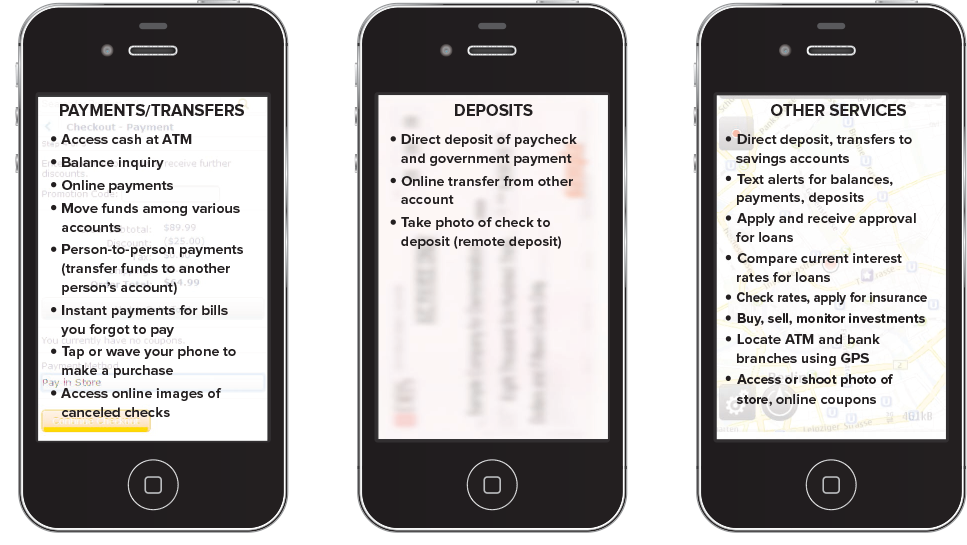
©McGraw-Hill Education
Financial service activities through a smartphone app have three access methods: (1) text banking, providing account information and conducting transactions through text messages; (2) mobile web banking with online access to the financial institution’s website; and (3) banking apps to conduct transactions using the mobile application of a bank or credit union.
Mobile and online banking provide the benefits of convenience and saving time along with instant information access. However, concerns of privacy, security of data, ease of overspending, costly fees, and online scams must be considered.
More traditional electronic banking can occur through an automati c teller machine (ATM), also called a cash machine, which can facilitate various types of transactions. To minimize ATM fees, compare several financial institutions. Use your own bank’s ATM to avoid surcharges, and withdraw larger amounts to avoid fees on several small transactions.
page 110
The debit card, or cash card, that activates ATM transactions is also used for purchases. A debit card is in contrast to a credit card, since you are spending your own funds rather than borrowing money. A lost or stolen debit card can be expensive. If you notify the financial institution within two days of the lost card, your liability for unauthorized use is $50. However, you can be liable for up to $500 of unauthorized use if you wait up to 60 days to notify your bank. After 60 days, your liability can be the total amount in your account and even more if your card is linked to other bank accounts.
Some card issuers use the same rules for lost or stolen debit cards as for credit cards: a $50 maximum. Of course, you are not liable for unauthorized use, such as a con artist using your account number to make a purchase. Remember to report the fraud within 60 days of receiving your statement to protect your right not to be charged for the transaction.
Systems now allow you to access ATMs without a debit card. Using a smartphone, both a cash code and the PIN will be required for cash. App customers may authorize another person in their phone contacts to receive money. The recipient will be sent a cash code to allow withdrawal of an approved amount.
Prepaid Debit Cards
Prepaid debit cards have become the fastest-growing payment method. For many consumers, these cards are being used instead of traditional banking services. Prepaid debit cards are issued by many financial service providers including traditional financial institutions, retailers (such as Walmart), and nonbank companies specifically created to provide this financial service.
“Loading” (adding funds to) prepaid debit cards may occur by cash, check, direct deposit, online transfer, smartphone check photo, or credit card cash advance. Common uses include in-store and online purchases as well as person-to-person payments. A savings account feature may also be connected to the card.
A major concern with prepaid debit cards has been the extensive number of fees that a user can encounter due to few current regulations for these financial products. Beware of fees that may include an activation fee, a monthly fee, a transaction fee, a cash-withdrawal (ATM) fee, a balance-inquiry fee, a fee to add funds, a dormancy fee, and others. Federal regulations requiring disclosure of prepaid debit card fees were recently enacted.
The expanded use of prepaid cards has resulted in lower consumer debt among some consumers since the debit card can help control spending and buying on credit. With credit cards, you “pay later”; with debit cards, you “pay now”; and with prepaid cards, you “pay before.”
Some prepaid cards have celebrity endorsements, which does not mean a better deal for consumers. Comparisons of features and fees for prepaid debit cards are available at www.nerdwallet.com/prepaid.
Wireless transactions will likely reduce debit and credit card use with cardless ATM access and in-store purchases. A smartphone, cash code, and PIN will be required. App customers may authorize cash to a phone contact. Recipients are sent a code to withdraw the approved amount. A credit card “lock and limit” app to control spending and block unauthorized transactions will also be available.
page 111
Financial Services and Economic Conditions
Changing interest rates, rising consumer prices, and other economic factors influence financial services. For successful financial planning, be aware of the current trends and future prospects for interest rates (see Exhibit 4–3). You can learn about these trends and prospects by reading The Wall Street Journal (www.wsj.com), The Financial Times (www.ft.com), the business section of daily newspapers, and business periodicals such as Bloomberg Businessweek (www.businessweek.com), Forbes (www.forbes.com), and Fortune (www.fortune.com).
Exhibit 4–3 Changing Interest Rates and Financial Service Decisions
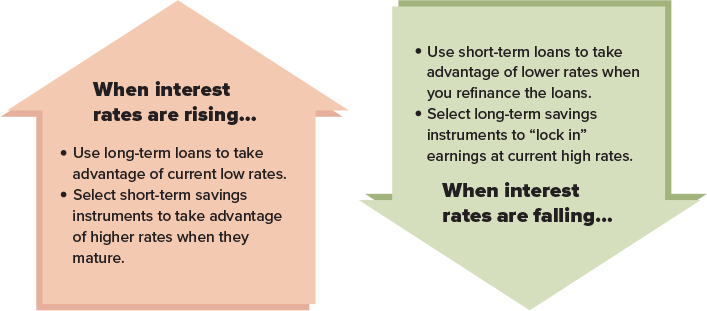
LO4.2
Compare the types of financial institutions.
Sources of Financial Services
Many types of businesses offer financial services that were once exclusive to banks.
Comparing Financial Institutions
The basic questions to ask when selecting a financial service provider are simple:
Where can I get the best return on my savings?
How can I minimize the cost of checking, payments services, and other fees?
Will I be able to borrow money if I need to?
As you use financial services, decide what you want from the organization that will serve your needs (see Exhibit 4–4). With the financial marketplace constantly changing, consider various factors before selecting your financial service provider.
Exhibit 4–4 Selecting a Financial Institution
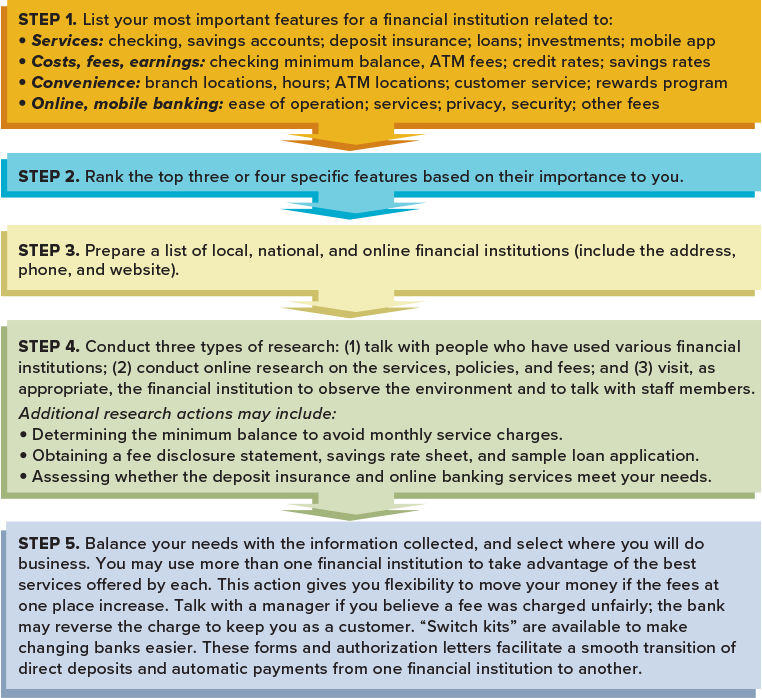
NOTE: Your Personal Financial Plan sheets 11, 12, and 14 at the end of the chapter can be used for this process. Also, a fee disclosure form is available at www.pewtrusts.org.
The services offered will likely be a major factor. In addition, personal service may be important to you. Convenience may take the form of branch office and ATM locations as well as online and mobile app services. Remember, convenience and service have a cost; compare fees and other charges at several financial institutions.
page 112
Finally, also consider safety and rates. Most financial institutions have deposit insurance to protect customers against losses; however, not all are insured by federal government programs. Obtain information about earnings on savings and checking accounts, and the rate you will pay for borrowed funds.
Types of Financial Institutions
Despite changes in the banking environment, many familiar financial institutions still serve your needs. As shown in Exhibit 4–1, some organizations (such as banks and credit unions) offer a wide range of services, while others provide specialized assistance, such as home loans. Distinctions among the various types of financial institutions are disappearing. For example, today people can buy investments through their bank and credit union as well as from an investment company or brokerage firm.
Deposit institutions serve as intermediaries between suppliers (savers) and users (borrowers) of funds. The most common of these traditional organizations are:
Commercial banks offer a full range of financial services, including checking, savings, lending, and most other services. Commercial banks, organized as corporations with investors (stockholders) contributing the needed capital page 113to operate, have several types: national banks, regional banks, community banks, and online-only banks.
Savings and loan associations (S&Ls) traditionally specialized in savings accounts and mortgages. Today, these organizations have expanded to offer financial services comparable to those of a bank.
Mutual savings banks, owned by depositors, also specialize in savings accounts and mortgages. Located mainly in the northeastern United States, the profits of a mutual savings bank are shared by depositors usually through higher rates on savings.
Credit unions are user-owned, nonprofit, cooperative organizations. Although members traditionally had a common bond such as work location, church, or community affiliation, credit union membership today is more flexible, with more than 80 million people belonging to one. Annual banking studies consistently report lower fees and lower loan rates with higher satisfaction levels for credit unions compared to other financial institutions.
Non-deposit institutions offer various financial services. These institutions include:
Life insurance companies. which provide financial security for dependents with various life insurance policies, some containing savings and investment features. Expanded activities of life insurance companies include investment and retirement planning services.
Investment companies, also called mutual funds, which offer a money market fund —a combination savings–investment plan. The company uses the money from many investors to purchase a variety of short-term financial instruments. However, unlike accounts at most deposit institutions, investment company accounts are not covered by federal deposit insurance.
Brokerage firms, which employ investment advisers and financial planners, and serve as an agent between the buyer and seller for stocks, bonds, and other investment securities. These companies obtain their earnings from commissions and fees. Expanded financial services are available from brokerage organizations, including checking accounts and online banking.
Credit card companies, which specialize in funding short-term retail lending. However, these networks, including VISA, MasterCard, and Discover, have also expanded into other banking and investing services.
Finance companies, which provide loans to consumers and small businesses. These loans have short and intermediate terms with higher rates than most other lenders charge. Most finance companies also offer other financial planning services.
Mortgage companies, which are organized primarily to provide loans for home purchases. The services of mortgage companies are presented in Chapter 7.
These and other financial institutions compete for your business. More and more of these companies are offering a combination of services (savings, checking, credit, insurance, investments) from one source.
page 114
Problematic Financial Businesses
Would you pay $8 to cash a $100 check? Or pay $20 to borrow $100 for two weeks? Many people who do not have bank accounts (especially low-income consumers) make use of financial service companies that charge very high fees and excessive interest rates. Over 10 million people in the United States are “unbanked,” using a variety of “shadow” financial services rather than having a bank account. Another 20 percent of the population are “underbanked” and make use of many of these services in addition to having a bank account.
PAWNSHOPS Loans through pawnshops are based on the value of tangible possessions such as jewelry or other valuable items. Many low- and moderate-income families use these organizations to obtain cash loans quickly. Pawnshops charge higher fees than other financial institutions. Thousands of consumers are increasingly in need of small loans—usually $50 to $75, to be repaid in 30 to 45 days. Pawnshops have become the “neighborhood bankers” and the “local shopping malls,” since they provide both lending and retail shopping services, selling items that borrowers do not redeem. While states regulate pawnshops, the interest rates charged can range from 3 percent a month to over 100 percent annually.
CHECK-CASHING OUTLETS Most financial institutions will not cash a check unless you have an account. The more than 6,000 check-cashing outlets (CCOs) charge anywhere from 1 to 20 percent of the face value of a check; the average cost is 2 to 3 percent. However, for a low-income family, that can be a significant portion of the total household budget. CCOs, sometimes called currency exchanges, also offer services, including electronic tax filing, money orders, private postal boxes, utility bill payment, and the sale of transit tokens. A person may be able to obtain these services at a lower cost at other locations.
PAYDAY LOAN COMPANIES Many consumer organizations caution against using payday loans, also referred to as cash advances, check advance loans, postdated check loans, and delayed deposit loans. Desperate borrowers pay annual interest rates of as much as 780 percent and more to obtain needed cash from payday loan companies. The most frequent users of payday loans are workers who have become trapped by debts or poor financial decisions. State and federal regulations have been introduced to reduce the potential exploitation of payday loan clients.
In a typical payday loan, a consumer writes a personal check for $115 to borrow $100 for 14 days. The payday lender agrees to hold the check until the next payday. This $15 finance charge for the 14 days translates into an annual percentage rate of 391 percent. Some consumers “roll over” their loans, paying another $15 for the $100 loan for the next 14 days. After a few rollovers, the finance charge can exceed the amount borrowed. To prevent this exploitation, some employers are offering pay advances through payroll provider services. The loans have rates in the 9 to 18 percent range.
RENT-TO-OWN CENTERS Rental businesses offer big-screen televisions, computers, seven-piece bedroom sets, and kitchen appliances. The rent-to-own (RTO) industry is defined as stores that lease products to consumers who can own the item if they complete a certain number of monthly or weekly payments. A $600 computer can result in $1,900 of payments. Many RTO purchases can result in annual interest rates of over 300 percent.
CAR TITLE LOAN COMPANIES When in need of money, people with poor credit ratings might obtain a cash advance using their automobile title as security for a high-interest loan. These loans, usually due in 30 days, typically have a cost similar to payday loans, often exceeding 200 percent. While the process is simple, the consequences can be devastating with the repossession of your car.
page 115
These expensive, high-risk financial service providers should be avoided. Instead, make an effort to properly manage your money and use the services of a reputable financial institution, such as a credit union.
LO4.3
Assess various types of savings plans.
Comparing Savings Plans
A savings plan is an important tool for attaining your financial goals. A range of savings alternatives exist (Exhibit 4–5). The various savings plans can be grouped into the following main categories.
Exhibit 4–5 Savings Alternatives
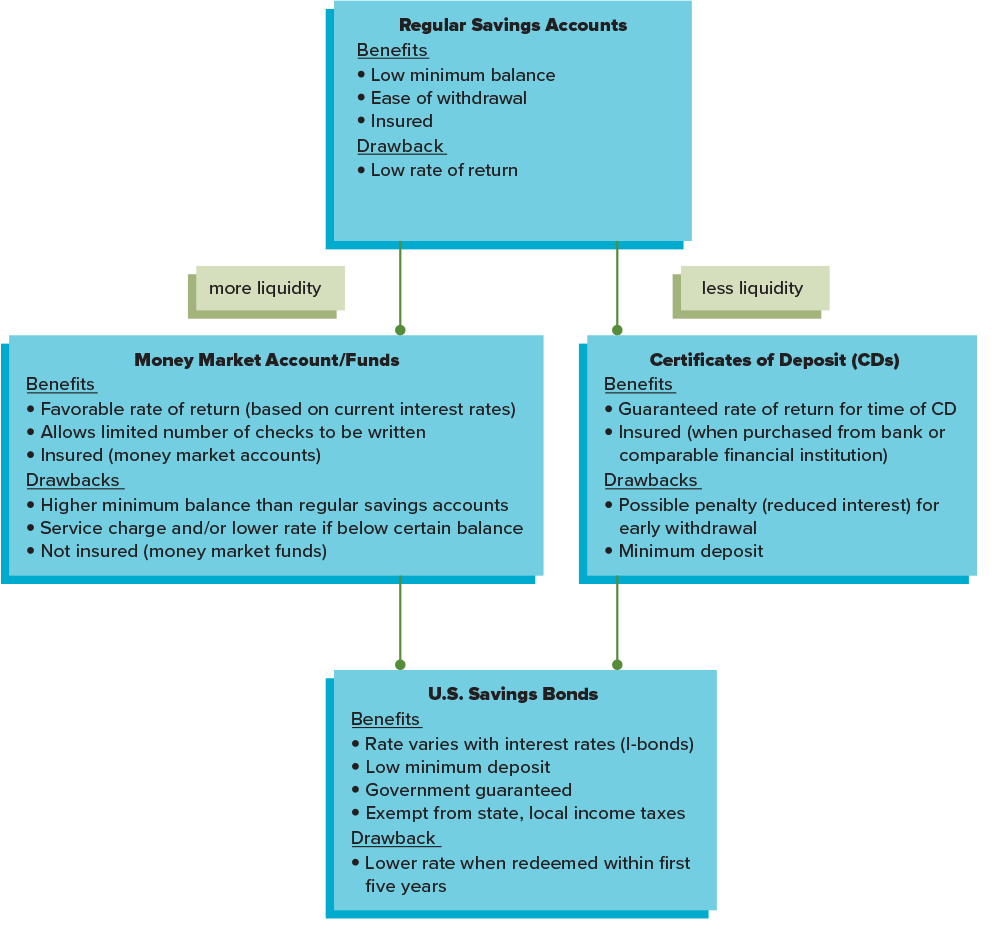
Regular Savings Accounts
Regular savings accounts, previously called passbook or statement accounts, usually involve a low or no minimum balance and allow you to withdraw money as needed. Banks, savings and loan associations, and other financial institutions offer regular savings accounts. At a credit union, these savings plans are called share accounts.
Certificates of Deposit
Higher earnings are available to savers when they leave money on deposit for a set time period. A certificate of deposit (CD) is a savings plan requiring that a certain amount be left on deposit for a stated time period (ranging from 30 days to five or more years) to earn a specific rate of return.
These time deposits can be an attractive and safe savings alternative. However, most financial institutions impose a penalty for early withdrawal of CD funds. For CDs of one year or less, the penalty is usually three months of interest. CDs of more than a year will likely have a fine of six months’ interest, while a five-year CD can result in a penalty as high as 20 to 25 percent of the total interest to maturity on the account.
TYPES OF CDS While traditional certificates of deposit continue to be the most popular, financial institutions offer other types of CDs:
Rising-rate or bump-up CDs may have higher rates at various intervals, such as every six months. However, beware of ads that highlight a higher rate in the future. This rate may be in effect only for the last few months of an 18- or 24-month CD.
Liquid CDs offer an opportunity to withdraw money without a penalty. However, you will likely be required to maintain a minimum balance in the account. This type of CD may have other restrictions such as a “waiting period” before any funds can be withdrawn or a limit on the number of withdrawals allowed.
page 116
A zero-coupon CD is purchased at a deep discount (a small portion of the face value) with no interest payments. Your initial small deposit ($5,000, for example) grows to the maturity value of the CD ($10,000) in 10 years, which is approximately a 6 percent annual return.
Indexed CDs have earnings based on the stock market. In times of strong stock performance, your earnings can be higher than those on other CDs. At other times, however, you may earn no interest and may even lose part of your savings. A CD based on the consumer price index can result in higher returns as inflation increases.
Callable CDs start with higher rates and usually have long maturities, as high as 10 to 15 years. With this savings option, if interest rates drop, the bank may “call” (close) the account after a set period, such as one or two years. When the call option is exercised, the saver receives the original deposit amount and any interest that has been earned.
Beware of promotional CDs that attempt to attract savers with gifts or special rates. Be sure to balance the value of the item against the lost interest.
page 117
MANAGING CDS When first buying or rolling over a CD (buying a new one at maturity), investigate potential earnings and costs. Do not allow your financial institution to automatically roll over your money into another CD for the same term. If interest rates have dropped, you might consider a shorter maturity. Or if you believe rates are at a peak and you won’t need the money for some time, obtain a CD with a longer term.
Consider creating a CD portfolio with CDs maturing at different times; for example, $2,000 in a three-month CD, $2,000 in a six-month CD, $2,000 in a one-year CD, and $2,000 in a two-year CD. This will give you some degree of liquidity and flexibility when you reinvest your funds.
Interest-Earning Checking Accounts
Checking accounts often have a savings feature. These interest-earning accounts usually pay a low interest rate. Recently, however, some financial institutions offered high-rate checking accounts to customers who meet certain requirements. For example, a higher interest rate might be available if you use your debit card a certain number of times each month and agree to use online statements.
Money Market Accounts and Funds
A money market account is a savings account that requires a minimum balance with earnings based on the changing market level of interest rates. Money market accounts may allow a limited number of checks to be written and may impose a fee when the account balance goes below the required minimum, usually $1,000.
Both money market accounts and money market funds offer earnings based on current interest rates, and both have minimum-balance restrictions and allow check writing. The major difference is in safety. Money market accounts at banks and savings and loan associations are covered by federal deposit insurance. This is not true of money market funds, which are a product of investment and insurance companies. Since money market funds invest mainly in short-term (less than a year) government and corporate securities, as savings, they are usually fairly safe.
U.S. Savings Bonds
U.S. savings bonds are a low-risk savings program guaranteed by the federal government and used to achieve financial goals. The Treasury Department offers several programs for buying savings bonds.
Series EE bonds are the most common, involving amounts greater than $25. These bonds were originally in a paper format and purchased for set values ranging from $25 to $5,000, with maturity values of $50 to $10,000. Today, most EE bonds are bought and managed online, and may be purchased for any amount increasing in value from interest earned. If you redeem the bonds before five years, you forfeit the latest three months of interest; after five years, you are not penalized. A bond must be held for one year before it can be cashed. Series EE bonds continue to earn interest for 30 years.
The tax advantages of series EE bonds are (1) the interest earned is exempt from state and local taxes and (2) federal income tax on earnings is not due until the bonds are redeemed. Redeemed series EE bonds may be exempt from federal income tax if the funds are used to pay tuition and fees at a college, university, or qualified technical school for yourself or a dependent. The bonds must be purchased by an individual who is at least 24 years old, and page 118they must be issued in the names of one or both parents. This provision is designed to assist low and middle-income households; people whose incomes exceed a certain amount do not qualify for this tax exemption.
With the I bond, you earn interest based on a fixed rate and an inflation rate. Every six months a new rate is set. I bonds are purchased at face value for an amount starting at $25. As with EE bonds, the minimum holding period is one year. Interest earned on I bonds is added to the value of the bond and received when you redeem your bond. I bonds have the same tax and education benefits as EE bonds.
A person may purchase up to $10,000 worth of savings bonds of each series (EE and I bonds) a year, for a total of $20,000. This amount applies to any person, so parents may buy an additional $20,000 in each child’s name. A TreasuryDirect account at www.treasurydirect.gov allows you 24-hour access to buy, manage, and redeem savings bonds. You can also invest in other Treasury securities such as bills, notes, bonds, and TIPS (Treasury inflation-protected securities).
Evaluating Savings Plans
Selection of a savings plan is most often influenced by the rate of return, inflation, tax considerations, liquidity, safety, restrictions, and fees (see Exhibit 4–6).
Exhibit 4–6 Selecting a Savings Plan
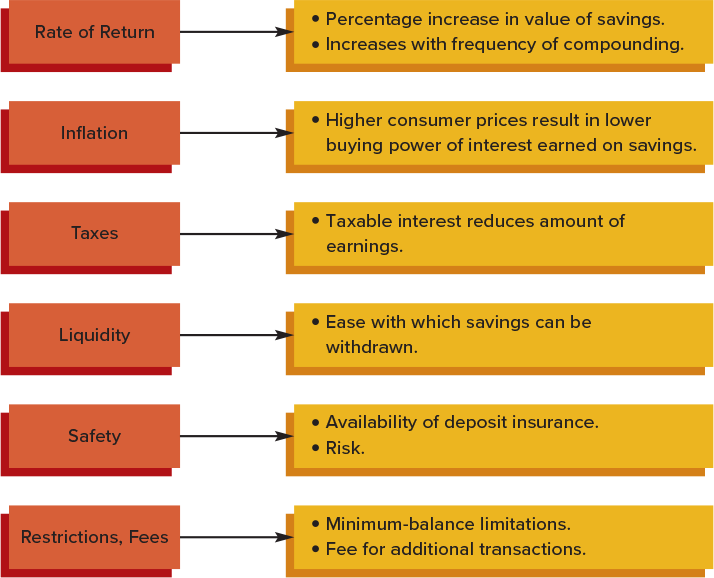
RATE OF RETURN Earnings on savings can be measured by the rate of return, or yield, the percentage of increase in the value of your savings from earned interest. For example, a $100 savings account that earned $5 after a year would have a rate of return, or yield, of 5 percent. This rate of return was determined by dividing the interest earned ($5) by the page 119amount in the savings account ($100). The yield on your savings usually will be greater than the stated interest rate.
Compounding refers to interest that is earned on previously earned interest. Each time interest is added to your savings, the next interest amount is computed on the new balance in the account. The more frequent the compounding, the higher your rate of return will be. For example, $100 in a savings account that earns 6 percent compounded annually will increase $6 after a year. But the same $100 in a 6 percent account compounded daily will earn $6.19 for the year. Although this difference may seem slight, large amounts held in savings for long periods of time will result in greater differences (see Exhibit 4–7).
Exhibit 4–7 Compounding Frequency Affects the Savings Yield
Shorter compounding periods result in higher yields. This chart shows the growth of $10,000, earning a rate of 4 percent, but with different compounding methods. |
||||
|
COMPOUNDING METHOD |
|||
End of year |
Daily |
Monthly |
Quarterly |
Annually |
1 |
$10,408 |
$10,407 |
$10,405 |
$10,400 |
2 |
10,832 |
10,831 |
10,827 |
10,816 |
3 |
11,275 |
11,272 |
11,267 |
11,249 |
4 |
11,735 |
11,731 |
11,724 |
11,699 |
5 |
12,214 |
12,208 |
12,198 |
12,165 |
10 |
14,918 |
14,904 |
14,883 |
14,800 |
15 |
18,221 |
18,196 |
18,160 |
18,004 |
20 |
22,254 |
22,215 |
22,154 |
21,902 |
Annual yield |
4.08% |
4.07% |
4.05% |
4.00% |
The Truth in Savings Act requires financial institutions to disclose the following information on savings account plans: (1) fees on deposit accounts; (2) the interest rate; (3) the annual percentage yield (APY); and (4) other terms and conditions of the savings plan. Truth in Savings (TIS) defines annual percentage yield (APY) as the percentage rate expressing the total amount of interest that would be received on a $100 deposit based on the annual rate and frequency of compounding for a 365-day period. APY reflects the amount of interest a saver should expect to earn.
INFLATION The rate of return you earn on your savings should be compared with the inflation rate. When inflation was over 10 percent, people with money in savings accounts earning 5 or 6 percent were experiencing a loss in the buying power of that money. In general, as the inflation rate increases, the interest rates offered to savers also increase.
page 120
TAXES Like inflation, taxes reduce interest earned on savings. For example, a 10 percent return for a saver in a 28 percent tax bracket means a real return of 7.2 percent (the Figure It Out! feature shows how to compute the after-tax savings rate of return). As discussed in Chapter 3, several tax-exempt and tax-deferred savings plans and investments can increase your real rate of return.
LIQUIDITY Liquidity allows you to withdraw your money on short notice without a loss of value or fees. Some savings plans impose penalties for early withdrawal or have other restrictions. With certain types of savings certificates and accounts, early withdrawal may be penalized by a loss of interest or a lower earnings rate. Consider the degree of liquidity you desire in relation to your savings goals. To achieve long-term financial goals, many people trade off liquidity for a higher return.
SAFETY Most savings plans at banks, savings and loan associations, and credit unions are insured by agencies affiliated with the federal government. Federal Deposit Insurance Corporation (FDIC) coverage prevents a loss of money due to the failure of the insured institution. Credit unions may obtain deposit insurance through the National Credit Union Association (NCUA). Some state-chartered credit unions have opted for a private insurance program. While some financial institutions have failed in recent years, savers with deposits covered by federal insurance have not lost any money. Depositors have either been paid or have had the accounts taken over by a financially stable institution.
The FDIC insures amounts of up to $250,000 per depositor per insured financial institution. Coverage amounts that exceed the limit are possible by using different ownership categories, such as individual, joint, and trust ownership accounts. For example, a joint account, held by two people, would be covered up to $500,000, with each account owner having $250,000 of coverage. Remember, however, that different branch offices count as the same institution, and mergers in the financial service industry may bring accounts from different banks together.
page 121
Gerstner, Lisa, “Start Saving Now” Reprinted by permission from Kiplinger’s Personal Finance, June 2014. Copyright ©2014. The Kiplinger Washington Editors, Inc.
What are current and long-term consequences of not saving?
Describe actions that you might consider to improve your savings attitude and habits.
Based on the information in this article and your experiences, what suggestions would you offer for selecting a bank?
page 122
The FDIC and NCUA also provide deposit insurance for certain retirement accounts, up to $250,000, including traditional IRAs, Roth IRAs, Simplified Employee Pension (SEP) IRAs, and Savings Incentive Match Plans for Employees (SIMPLE) IRAs as well as self-directed Keogh accounts and various plans for state government employees. Of course, this coverage applies only to retirement accounts in financial institutions insured by the FDIC and NCUA.
To determine if all of your deposits are insured, use the Electronic Deposit Insurance Estimator (EDIE) at www.fdic.gov/edie/index.html. This feature includes a step-by-step tutorial with depositor situations for different types of account and different ownership. Information about credit union deposit coverage is available at www.ncua.gov. Since not all financial institutions have federal deposit insurance, investigate this matter when you are selecting a savings plan. Additional information on the regulation and consumer protection aspects of financial institutions is included in Appendix C.
EXAMPLE: Deposit Insurance
If you have a $562,000 joint account with a relative in an FDIC-insured financial institution, $31,000 of your savings will not be covered by federal deposit insurance. One-half of the $562,000 exceeds the $250,000 limit by $31,000.
RESTRICTIONS AND FEES Other limitations can affect your choice of a savings program. For example, there may be a delay between the time interest is earned and the time it is added to your account. This means the interest will not be available for your immediate use. Also, some institutions charge a transaction fee for each deposit or withdrawal. In the past, financial institutions offered a “free gift” when a certain savings amount was deposited. To receive this gift, you had to leave your money on deposit for a certain time period or you received less interest, since some of the earnings covered the cost of the “free” items.
What are the main types of savings plans offered by financial institutions?
How does a money market account differ from a money market fund?
How do inflation and taxes affect earnings on savings?
In the following financial situations, check the box that is the major influence for the person when selecting a savings plan:
Financial Planning Situation
Rate of Return
Inflation
Taxes
Liquidity
Safety
An older couple needs easy access to funds for living expenses.
A person is concerned with loss of buying power of funds on deposit.
A saver desires to maximize earnings from the savings plan.
A middle-aged person wants assurance that the funds are safe.
LO4.4
Evaluate different types of payment methods.
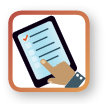
ACTION ITEM
My payment account balance is:
updated regularly.
based on a rough estimate.
only known by my financial institution.
page 123
Comparing Payment Methods
Each year, paper checks account for a smaller portion of payments in our society. While check writing is being used less, checking accounts are still the common source for most debit card transactions and online payments. As shown in Exhibit 4–8, payment alternatives may be viewed in three main categories.
Exhibit 4–8 Payment Alternatives
Digital Payments |
Checking Accounts |
Other Payment Methods |
Debit (cash) and credit cards |
Regular checking account |
Certified check |
Online, mobile payments |
Activity checking account |
Cashier’s check |
Stored-value (prepaid) cards |
Interest-earning account |
Money order |
Smart cards (“digital wallet”) |
|
Traveler’s checks |
Peer-to-peer (P2P) payments |
|
|
Digital Payments
Transactions not involving cash, checks, or credit cards have expanded with technology, improved security, and increased consumer acceptance.
DEBIT CARD TRANSACTIONS Nearly every store and online retailer processes debit card transactions, with the amount of the purchase deducted from your checking or other bank account. Most debit cards can be used two ways: (1) with your signature, like a credit card, and (2) with your personal identification number (PIN), like an ATM card. When the debit card is processed like a credit card, you have more security in case of a fraudulent transaction or a purchase dispute. But when using a debit card to check into a hotel, buy gas, or rent a car, a merchant may freeze an amount in your bank account above what you actually spend. This hold on your funds could result in an overdrawn account.
Use a credit card to . . . . . . delay the payment for a purchase. . . . build a credit history with wise buying. . . . buy online or for major purchases. . . . earn more generous rewards points for spending. |
Use a debit card to . . . . . . limit your spending to available money. . . . avoid bills that will be paid in the future. . . . avoid interest payment or an annual fee. . . . obtain better protection if you process a transaction as a credit card. |
ONLINE PAYMENTS Banks and online companies serve as third parties to facilitate online bill payments. These organizations include www.paypal.com, www.mycheckfree.com, www.paytrust.com, and Google Wallet. Some online payment services give you a choice of using a credit card or a bank account, while others require one or the other. Linking a transaction to your checking account, rather than to a credit card, may not give you as much leverage when disputing a transaction.
As cyber currencies, such as Bitcoin, gain popularity, beware of potential dangers. Also called a cryptocurrency or a virtual currency, these digital assets serve as a payment method using cryptography. The main benefits of these alternative digital currencies are freedom of flexibility when making payments along with control and security. However, concerns include: (1) a lack of awareness and understanding among users and merchants; (2) uncertainty of the changing value of the currency unit, which will likely stabilize as acceptance grows; (3) risks of continuing development related to new features while making the digital currency more secure and accessible.
People without a credit or debit card can use PayNearMe for online buying and other transactions. This service allows buyers to make a purchase and then pay cash at a local store. The consumer receives a receipt and the seller is notified of the payment. This cash transaction network may be used for online purchases, telephone orders, loan repayments, money transfers, and other transactions that might require a credit card. page 124PayNearMe has partnerships with several major online and storefront retailers. When using these services, be sure to consider all fees, online security, and customer service availability.
MOBILE TRANSFERS Apps for mobile payment systems through smartphones, tablets, and other wireless devices are expanding. The near-field communications technology stores credit card and bank account information. These wireless devices replace debit and credit cards for processing financial and purchasing transactions. A tap or wave of your phone at the point-of-sale terminal sensor completes the purchase. While these mobile transactions usually occur through a bank account, in the future these payments may bypass banks with charges directly on your phone bill.
Mobile banking is increasing the availability of “person-to-person” payments with the transfer of funds by e-mail or to a mobile phone number. The opportunity to send and receive money through links to bank accounts and cards may also occur with online payment services.
STORED-VALUE CARDS Prepaid cards for telephone service, transit fares, highway tolls, laundry service, and school lunches are common. While some of these stored-value cards are disposable, others can be reloaded with an additional amount. Also called prepaid debit cards, some stored-value cards may have activation charges, ATM fees, and other transaction costs. Recipients of government benefits may receive Social Security and other payments on a prepaid debit card, which is practical for people without a bank account.
SMART CARDS These “digital wallets” are similar to other ATM cards with an imbedded microchip. In addition to banking activities, the card may also store past purchases, insurance information, and your medical history. Recent developments in smart cards include an option that allows you to pay with reward points.
PEER-TO-PEER PAYMENTS Various services allow you to transfer money to another person. While most require registering debit card, credit card, or bank account information, some peer-to-peer (P2P) payments are conducted by e-mail and with a secured website. Fees for the P2P service can range from less than a dollar to a percentage of the amount transferred.
Checking Accounts
Even as mobile and online payments expand in use, a checking account is still necessary for most people. Checking accounts fall into three major categories: regular checking accounts, activity accounts, and interest-earning checking accounts.
REGULAR CHECKING ACCOUNTS Regular checking accounts usually have a monthly service charge that you may avoid by keeping a minimum balance in the account. Some financial institutions will waive the monthly fee if you keep a certain amount in savings. Avoiding the monthly service charge can be beneficial. For example, a monthly fee of $7.50 results in $90 a year. However, you lose interest on the minimum-balance amount in a non-interest-earning account.
ACTIVITY ACCOUNTS Activity accounts charge a fee for each check written and sometimes a fee for each deposit in addition to a monthly service charge. However, you do not have to maintain a minimum balance. An activity account is most appropriate for people who write only a few checks each month and are unable to maintain the required minimum balance.
page 125
INTEREST-EARNING CHECKING Interest-earning checking accounts usually require a minimum balance. If the account balance goes below this amount, you may not earn interest and will likely incur a service charge. These are called share draft accounts at credit unions.
Evaluating Checking and Payment Accounts
Would you rather have a checking account that pays interest and requires a $1,000 minimum balance or an account that doesn’t pay interest and requires a $300 minimum balance? This decision requires evaluating factors such as restrictions, fees and charges, interest, and special services (see Exhibit 4–9).
Exhibit 4–9 Checking Account Selection Factors
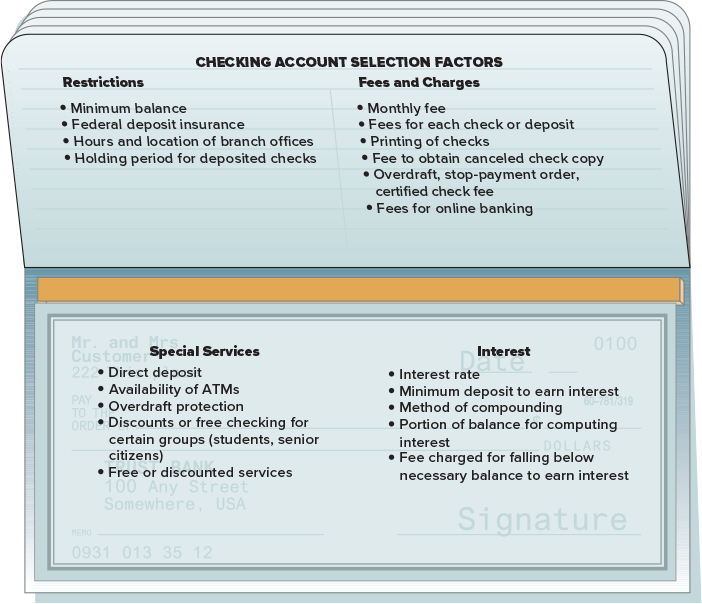
RESTRICTIONS The most common limitation on a checking account is the required amount that must be kept on deposit to earn interest or avoid a service charge. In the past, financial institutions placed restrictions on the holding period for deposited checks. A waiting period was usually required before you could access the funds. The Check Clearing for the 21st Century Act (known as Check 21) shortens the processing time. This law establishes the substitute check, which is a digital reproduction of the original paper check, and is considered a legal equivalent of the original check.
FEES AND CHARGES Nearly all financial institutions require a minimum balance or impose service charges for checking accounts. When using an interest-bearing checking account, compare your earnings with any service charge or fee. Also, consider the cost of lost or reduced interest resulting from maintaining the minimum balance. Checking account fees have increased in recent years. Items such as check printing, overdraft fees, and stop-payment orders have doubled or tripled in price at some financial institutions.
INTEREST The interest rate, the frequency of compounding, and the interest computation method will affect the earnings on your checking account.
page 126
SPECIAL SERVICES As financial institutions attempt to reduce paper and postage costs, canceled checks are no longer returned. Bank customers are provided with more detailed monthly statements and will likely have online access to view and print checks that have been paid.
Overdraft protection is an automatic loan made to checking account customers for checks written in excess of their balance. This service is convenient but costly. Most overdraft plans make loans based on $50 or $100 increments. An overdraft of just $1 might trigger a $50 loan and corresponding finance charges of 18 percent or more. But overdraft protection can be less costly than the fee charged for a check you write when you do not have enough money on deposit to cover it. That fee may be $30 or more. Federal regulations require a financial institution to obtain permission from a customer before being part of an overdraft protection program. Many financial institutions will allow you to cover checking account overdrafts with an automatic transfer from a savings account for a nominal fee.
overdraft protection An automatic loan made to checking account customers to cover the amount of checks written in excess of the available balance in the checking account.
Beware of checking accounts packaged with several services (safe deposit box, traveler’s checks, low-rate loans, and travel insurance) for a single monthly fee. This may sound like a good value; however, financial experts observe that only a small group of people make use of all services in the package.
WHAT WOULD YOU DO? You are considering these two checking accounts: Account 1: A regular checking account with a monthly fee of $6 when the balance goes below $300. Account 2: An interest-earning checking account (paying 0.6 percent), with a monthly charge of $3 if the balance goes below $100. List the costs and benefits of these two checking accounts. Which account would you select?
Other Payment Methods
A certified check is a personal check with guaranteed payment. The amount of the check is deducted from your balance when the financial institution certifies the check. A cashier’s check is a check issued by a financial institution. You may purchase one by paying the amount of the check plus a fee. You may purchase a money order in a similar manner from financial institutions, post offices, and stores. Certified checks, cashier’s checks, and money orders allow you to make a payment that the recipient knows is valid.
Traveler’s checks allow you to make payments when you are away from home. This payment form, which has declined in use, requires you to sign each check twice. First, you sign the traveler’s checks when you purchase them. Then, to identify you as the authorized person, you sign them again as you cash them. Electronic traveler’s checks, in the form of a prepaid travel card, have become more common. The card allows travelers visiting other nations to get local currency from an ATM.
Managing Your Checking Account
Obtaining and using a checking account involve several activities.
OPENING A CHECKING ACCOUNT First, decide who the owner of the account is. Only one person is allowed to write checks on an individual account. A joint account has two or more owners. Both an individual account and a joint account require a signature card. This document is a record of the official signatures of the person or persons authorized to write checks on the account.
page 127
MAKING DEPOSITS A deposit ticket is used for adding funds to your checking account. On this document, you list the amounts of cash and checks being deposited. Each check you deposit requires an endorsement—your signature on the back of the check—to authorize the transfer of the funds into your account. The three common endorsement forms are:
A blank endorsement is just your signature, which should be used only when you are actually depositing or cashing a check, since a check may be cashed by anyone once it has been signed.
A restrictive endorsement consists of the words for deposit only, followed by your signature, which is especially useful when you are depositing checks.
A special endorsement allows you to transfer a check to someone else with the words pay to the order of followed by the name of the other person and then your signature.
Each year, consumers lose millions of dollars by accepting phony checks, money orders, and wire transfers for online transactions and other business activities. Information and videos on check scams may be obtained at www.fakechecks.org. See the nearby Financial Literacy in Practice feature for more information on avoiding scams and identity theft.
WRITING CHECKS Before writing a check, record the information in your check register and deduct the amount of the check from your balance. Many checking account customers use duplicate checks to maintain a record of their current balance.
The procedure for proper check writing has the following steps: (1) record the date; (2) write the name of the person or organization receiving the payment; (3) record the amount of the check in numerals; (4) write the amount of the check in words; checks for less than a dollar should be written as “only 79 cents,” for example, and cross out the word dollars on the check; (5) sign the check; (6) note the reason for payment.
A stop-payment order may be necessary if a check is lost or stolen. Most banks do not honor checks with “stale” dates, usually six months old or older. The fee for a stop-payment commonly ranges from $20 to more than $30. If several checks are missing or you lose your checkbook, closing the account and opening a new one is likely to be less costly than paying several stop-payment fees.
RECONCILING YOUR CHECKING ACCOUNT Each month you will receive a bank statement summarizing deposits, checks paid, ATM withdrawals, interest earned, and fees such as service charges and printing of checks. The balance reported on the statement will usually differ from the balance in your checkbook. Reasons for a difference may include checks that have not yet cleared, deposits not received by the bank, and interest earned.
To determine the correct balance, prepare a bank reconciliation, to account for differences between the bank statement and your checkbook balance. This process involves the following steps:
Compare the checks written with those reported as paid on the statement. Use the canceled checks, or compare your check register with the check numbers reported on the bank statement. Subtract from the bank statement balance the total of the checks written but not yet cleared.
Determine whether any deposits made are not on the statement; add the amount of the outstanding deposits to the bank statement balance.
Subtract fees or charges on the bank statement and ATM withdrawals from your checkbook balance.
Add any interest earned to your checkbook balance.
page 128
People who put their Social Security and driver’s license numbers on their checks are making identity theft easy. With one check, a con artist could know your Social Security, driver’s license, and bank account numbers as well as your address, phone number, and perhaps even a sample of your signature.
An attorney had his wallet stolen. Within a week, the thieves ordered an expensive monthly cell phone package, applied for a Visa credit card, had a credit line approved to buy a computer, and received a PIN number from the Department of Motor Vehicles to change his driving record information online.
Identity fraud can range from passing bad checks and using stolen credit cards to theft of another person’s total financial existence. The following quiz can help you avoid becoming one of the thousands of people who have their identities stolen each day.
If you are a victim of identity theft, take the following actions:
File a police report immediately in the area where the item was stolen. This proves you were diligent and is a first step toward an investigation (if there ever is one).
Call the three national credit reporting organizations immediately to place a fraud alert on your name and Social Security number. The numbers are: Equifax, 1-800-525-6285; Experian (formerly TRW), 1-888-397-3742; and TransUnion, 1-800-680-7289.
Contact the Social Security Administration fraud line at 1-800-269-0271.
Additional information on financial privacy and identity theft is available at www.usa.gov/identity-theft and www.privacyrights.org.
Which of the following actions have you taken to avoid identity theft? |
Yes |
No |
Action needed |
|---|---|---|---|
|
|
|
|
|
|
|
|
|
|
|
|
|
|
|
|
|
|
|
|
|
|
|
|
|
|
|
|
|
|
|
|
|
|
|
|
|
|
|
|
|
|
|
|
|
|
|
|
page 129
At this point, the revised balances for both the checkbook and the bank statement should be the same. If the two do not match, check your math; make sure every check and deposit was recorded correctly.
EXAMPLE: Bank Reconciliation
To determine the true balance in your checking account:

A failure to reconcile your bank account each month can result in not knowing:
Your exact spending habits for wise money management.
If the correct deposit amounts have been credited to your account.
Any unauthorized ATM withdrawals.
If your bank is overcharging you for fees.
Errors that your bank may have made in your account.
What factors are commonly considered when selecting a checking account?
Describe situations in which you might use a certified check, cashier’s check, or money order.
Based on the following information, determine the true balance in your checking account.
Balance in your checkbook, $356
Balance on bank statement, $472
Service charge and other fees, $15
Interest earned on the account, $4
Total of outstanding checks, $187
Deposits in transit, $60
page 130
YOUR PERSONAL FINANCE ROAD MAP AND DASHBOARD: PERCENT SAVINGS RATE
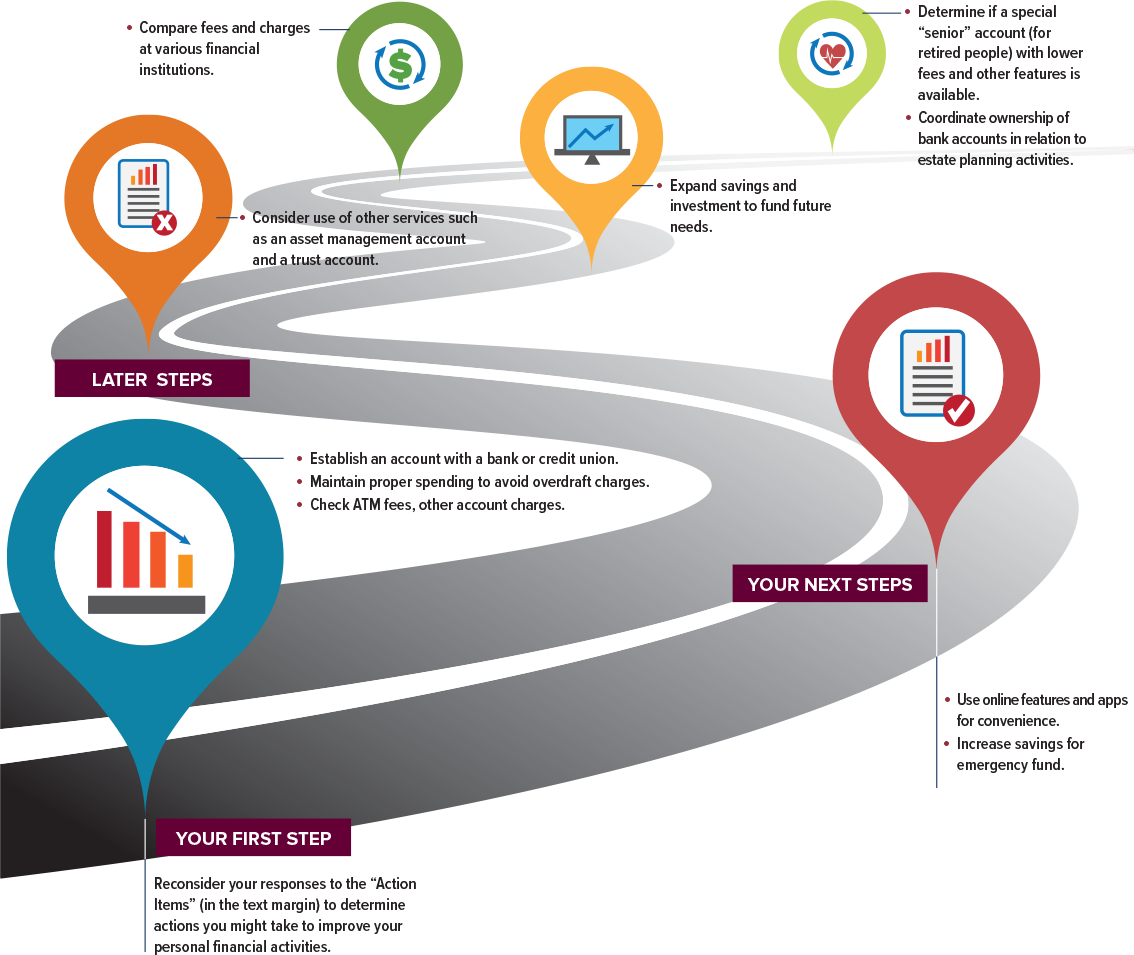
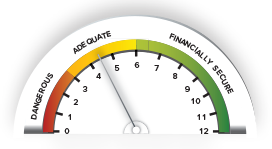
A key indicator of financial success is the percentage of income saved each month. Various savings instruments can be used to implement this element of your financial plan. While most people save nothing or very little, financial experts recommend a savings rate of 5 to 10 percent. These funds might be used for emergencies, short-term financial goals, or long-term financial security.
YOUR SITUATION: Do you set aside an amount for savings each month? How can you reduce expenses or increase income for expanded savings? An improving savings rate is the foundation for progress toward financial independence.
page 131
Chapter Summary

LO4.1 Financial products such as savings plans, checking accounts, loans, trust services, and electronic banking are used for managing daily financial activities.
LO4.2 Commercial banks, savings and loan associations, mutual savings banks, credit unions, life insurance companies, investment companies, finance companies, mortgage companies, pawnshops, and check-cashing outlets may be compared on the basis of services offered, rates and fees, safety, convenience, and special programs available to customers.
LO4.3 Commonly used savings plans include regular savings accounts, certificates of deposit, interest-earning checking accounts, money market accounts, money market funds, and U.S. savings bonds. Savings plans may be evaluated on the basis of rate of return, inflation, tax considerations, liquidity, safety, restrictions, and fees.
LO4.4 Debit cards, online and mobile payment systems, and stored-value cards are increasing in use for payment activities. Regular checking accounts, activity accounts, and interest-earning checking accounts can be compared with regard to restrictions (such as a minimum balance), fees and charges, interest, and special services.
Key Terms

annual percentage yield (APY) 119
automatic teller machine (ATM) 109
certificate of deposit (CD) 115
savings and loan association (S&L) 113
Key Formulas

Page |
Topic |
Formula |
|---|---|---|
Annual percentage yield (APY) |
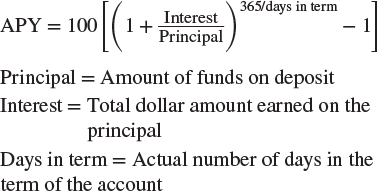 |
|
When the number of days in the term is 365 or where the account does not have a stated maturity, the APY formula is simply |
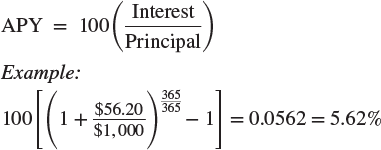 |
|
|
After-tax rate of return |
Interest rate × (1 – Tax rate) |
Self-Test Problems

What would be the annual percentage yield (APY) for a savings account that earned $174 on a balance of $3,250 over the past 365 days?
If you earned a 4.2 percent return on your savings, with a 15 percent tax rate, what is the after-tax rate of return?
page 132
Solutions
To calculate the APY when the number of days in the term is 365, use this formula:
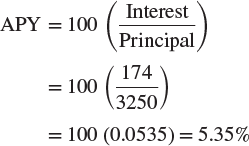
To calculate the after-tax rate of return use
Interest rate × (1 − Tax rate)
0.042 × (1 − 0.15) = 0.042 (0.85) = 0.0357 = 3.57%
Problems

An ATM with a service fee of $2 is used by a person 100 times in a year. What would be the future value in 10 years (use a 3 percent rate) of the annual amount paid in ATM fees? (LO4.1)
If a person has ATM fees each month of $18 for six years, what would be the total cost of those banking fees? (LO4.1)
A payday loan company charges 5 percent interest for a two-week period. What would be the annual interest rate from that company? (LO4.2)
For each of these situations, determine the savings amount. Use a financial calculator or the time value of money tables in the Chapter 1 appendix. (LO4.3)
What would be the value of a savings account started with $700, earning 4 percent (compounded annually) after 10 years?
Brenda Young desires to have $15,000 eight years from now for her daughter’s college fund. If she will earn 6 percent (compounded annually) on her money, what amount should she deposit now? Use the present value of a single amount calculation.
What amount would you have if you deposited $1,800 a year for 30 years at 8 percent (compounded annually)?
What would be the annual percentage yield for a savings account that earned $56 in interest on $800 over the past 365 days? (LO4.3)
With a 28 percent marginal tax rate, would a tax-free yield of 7 percent or a taxable yield of 9.5 percent give you a better return on your savings? Why? (LO4.3)
Janie has a joint account with her mother with a balance of $562,000. Based on $250,000 of Federal Deposit Insurance Corporation coverage, what amount of Janie’s savings would not be covered by deposit insurance? (LO4.3)
A certificate of deposit often charges a penalty for withdrawing funds before the maturity date. If the penalty involves two months of interest, what would be the amount for early withdrawal on a $20,000, 5 percent CD? (LO4.3)
What is the annual opportunity cost of a checking account that requires a $300 minimum balance to avoid service charges? Assume an interest rate of 3 percent. (LO4.4)
A bank that provides overdraft protection charges 12 percent for each $100 (or portion of $100) borrowed when an overdraft occurs. (LO4.4)
What amount of interest would the customer pay for a $188 overdraft? (Assume the interest is for the full amount borrowed for a whole year.)
How much would be saved by using the overdraft protection loan if a customer has three overdraft charges of $30 each during the year?
What would be the net annual cost of the following checking accounts? (LO4.4)
Monthly fee, $3.75; processing fee, 25 cents per check; checks written, an average of 14 a month.
Interest earnings of 4 percent with a $500 minimum balance; average monthly balance, $600; monthly service charge of $15 for falling below the minimum balance, which occurs three times a year (no interest earned in these months).
page 133
Based on the following information, prepare a bank reconciliation to determine the adjusted (corrected) balance: (LO4.4)
Bank balance, $680
Checkbook balance, $642
Outstanding checks, $112
Direct deposits, $70
Account fees, $12
ATM withdrawals, $80
Deposit in transit, $60
Interest earned, $8
|
To reinforce the content in this chapter, more problems are provided at connect.mheducation.com. |
Apply Yourself for Financial Literacy

Talk with two or three people about their online and mobile banking experiences. What apps have been beneficial? What problems have they encountered? How has online banking changed the way people select and use banking services? (LO4.1)
Using the websites www.cuna.org and www.culookup.com, obtain information about joining a credit union and the services offered. (LO4.2)
What actions would you recommend to someone who was considering using the services of a pawnshop, check-cashing outlet, or payday loan company? (LO4.2)
Obtain current interest rates for CDs and other savings plans at www.bankrate.com. How do these rates affect various personal financial decisions? (LO4.3)
Observe customers making payments in a retail store. How often are cash, checks, credit cards, debit cards, and other payment methods used? (LO4.4)
REAL LIFE PERSONAL FINANCE

EVALUATING BANKING SERVICES
“Wow! My account balance is a little lower than I expected,” commented Melanie Harper as she reviewed her bank statement. “Wait a minute! There’s nearly $20 in fees for ATM withdrawals and other service charges. Oh no! I also went below the minimum balance required for my free checking account,” Melanie groaned. “That cost me $7.50!”
Melanie is not alone in her frustration with fees paid for financial services. While careless money management caused many of these charges, others could have been reduced or eliminated by comparing costs at various financial institutions.
Melanie has decided to investigate various alternatives to her current banking services. Her preliminary research provided the following:
Mobile banking—allows faster access to account information to quickly transfer funds and make payments and purchases. May include access to expanded financial services, such as low-cost, online investment trading and instant loan approval.
Prepaid debit card—would prevent overspending and require staying within the budgeted amount loaded on the card. Cards are usually accepted in most retail locations and online. A variety of fees might be associated with the card.
Check-cashing outlet—would result in fees only when services are used, such as buying money orders, cashing a check, obtaining a prepaid cash card, or paying bills online.
Many people do not realize the amount they pay each month for various bank fees. Some basic research can result in saving several hundred dollars a year.
Questions
What benefits and drawbacks might Melanie encounter when using each of these financial services: mobile banking, prepaid debit card, and check-cashing outlet?
What factors should Melanie consider when selecting among these various banking services?
What actions might you take to better understand the concerns associated with using various banking services?
page 134
Continuing Case

FINANCIAL SERVICES: SAVINGS PLANS AND PAYMENT ACCOUNTS
Jamie Lee Jackson, age 26, is in her last semester of college and is anxiously awaiting graduation day, which is just around the corner! She still works part-time as a bakery clerk, has been sticking to her budget the past two years, and is on track to accumulate enough money for the $9,000 down payment she needs to open her cupcake café within the next two years.
Jamie Lee is still single, shares a small apartment with a friend, and continues to split all of the associated living expenses, such as rent and utilities. Unfortunately, she now has to seriously consider finding a place of her own.
One evening, after returning to the apartment after a long shift at the bakery, Jamie learned that her roommate had a couple of friends over earlier in the evening. As Jamie went to her room, she noticed that her top desk drawer had been left open and her debit/ATM card, as well as her checkbook and Social Security card, were missing. She immediately contacted the authorities, and the police instructed her to notify her financial institution immediately. But it was late Saturday night, and Jamie thought she had to now wait until Monday morning. Unfortunately, within no time, Jamie found that her checking account had been emptied!
Jamie Lee’s luck worsened, as she had paid many of her monthly bills late last week. Her automobile insurance, two utility bills, and a layaway payment had all been paid for by check. Her bank almost immediately began sending overdraft alerts through her smartphone for the emptied checking account.
Current Financial Situation
Bank Accounts:
Checking account, $2,250 (before the theft)
Savings account, $6,900
Emergency fund savings account, $3,900
401(k) balance, $350
Questions
Jamie Lee is beside herself knowing that the thieves had unauthorized use of her debit/ATM card. What is Jamie’s financial responsibility for the unauthorized use?
What would have been Jamie Lee’s financial liability had she waited more than two days to report the debit/ATM card lost or stolen?
Using Your Personal Financial Plan sheet 11, what financial service would benefit Jamie Lee now, as she had legitimate checks written to cover her monthly bills that are now in excess of the available checking account balance due to the theft?
Spending Diary

“MY CASH WITHDRAWALS HAVE RESULTED IN MANY ATM FEES THAT TAKE AWAY MONEY FROM OTHER BUDGET ITEMS.”
Directions Start (or continue) your Daily Spending Diary or use your own format to record and monitor spending in various categories. Your comments should reflect what you have learned about your spending patterns and help you consider possible changes you might make. The Daily Spending Diary sheets are located in Appendix D at the end of the book and in Connect Finance.
Questions
Are there any banking fees that you encounter each month? What actions might be taken to reduce or eliminate these cash outflows?
What other areas of your daily spending might be reduced or revised?
page 135
YOUR PERSONAL FINANCIAL PLAN 11
Name: ______________________________ Date: _____________________________
Planning the Use of Financial Services 
Purpose: To indicate currently used financial services and to determine services that may be needed in the future.
Financial Planning Activities: List (1) currently used services with financial institution information (name, address, phone), and (2) services that are likely to be needed in the future. This sheet is also available in an Excel spreadsheet format in Connect Finance.
Suggested Websites: www.bankrate.com, www.consumerfinance.gov, banking.about.com
Types of financial services |
Current financial services used |
Additional financial services needed |
|---|---|---|
Payment services (checking, ATM, online bill payment, money orders) |
Financial Institution |
|
|
|
|
|
|
|
Savings services (savings account, money market account, certificate of deposit, savings bonds) |
Financial Institution |
|
|
|
|
|
|
|
Credit services (credit cards, personal loans, mortgage) |
Financial Institution |
|
|
|
|
|
|
|
Other financial services (investments, trust account, tax planning) |
Financial Institution |
|
|
|
|
|
|
|
What’s Next for Your Personal Financial Plan?
Assess whether the current types and sources of your financial services are appropriate.
Determine additional financial services you may wish to use in the future.
page 136
YOUR PERSONAL FINANCIAL PLAN 12

©McGraw-Hill Education
Name: _____________________________ Date: _____________________________
Comparing Savings Plans 
Purpose: To compare the costs and benefits associated with different savings plans.
Financial Planning Activities: Analyze online information and contact various financial institutions to obtain the information requested below. This sheet is also available in an Excel spreadsheet format in Connect Finance.
Suggested Websites: www.bankrate.com, www.nerdwallet.com, www.savingsaccounts.com
Type of savings plan (regular savings account, certificates of deposit, interest-earning checking accounts, money market accounts and funds, U.S. savings bonds) |
|
|
|
Financial institution |
|
|
|
Address/phone |
|
|
|
Website |
|
|
|
Annual interest rate |
|
|
|
Annual percentage yield (APY) |
|
|
|
Frequency of compounding |
|
|
|
Insured by FDIC, NCUA, other |
|
|
|
Maximum amount insured |
|
|
|
Minimum initial deposit |
|
|
|
Minimum time period savings that must be on deposit |
|
|
|
Penalties for early withdrawal |
|
|
|
Service charges/transaction fees, other costs and fees |
|
|
|
Additional services, other information |
|
|
|
What’s Next for Your Personal Financial Plan?
Based on this savings plan analysis, determine the best types of savings plans for your current and future financial situation.
When analyzing savings plans, what factors should you carefully investigate?
page 137
YOUR PERSONAL FINANCIAL PLAN 13

©McGraw-Hill Education
Name: _____________________________ Date: _____________________________
Using Savings Plans to Achieve Financial Goals 
Purpose: Monitor savings to assist in reaching financial goals.
Financial Planning Activities: Record savings plan information along with the amount of your balance or income on a periodic basis. This sheet is also available in an Excel spreadsheet format in Connect Finance.
Suggested Websites: www.savingsbonds.gov, www.fdic.gov
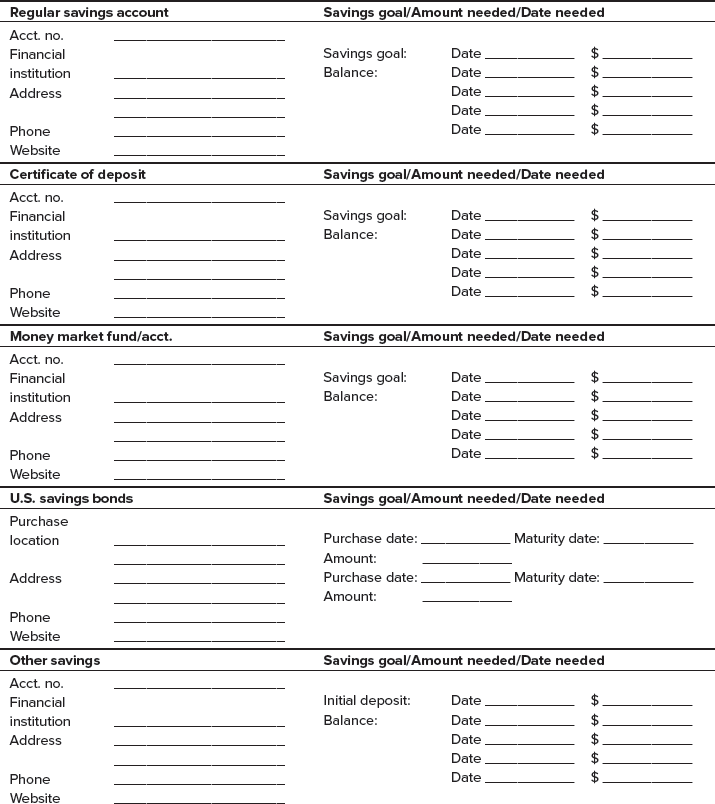
What’s Next for Your Personal Financial Plan?
Assess your current progress toward achieving various savings goals. Evaluate existing and new savings goals.
Plan actions to expand the amount you are saving toward various savings goals.
page 138
YOUR PERSONAL FINANCIAL PLAN 14

©McGraw-Hill Education
Name: _____________________________ Date: _____________________________
Comparing Payment Methods; Bank Reconciliation 
Purpose: To determine the adjusted cash balance for your checking account.
Financial Planning Activities: Compare checking accounts and payment services at various financial institutions (banks, savings and loan associations, credit unions, online banks). Enter data from your bank statement and checkbook for the amounts requested. This sheet is also available in an Excel spreadsheet format in Connect Finance.
Suggested Websites: www.bankrate.com, www.kiplinger.com, www.depositaccounts.com
Institution name |
|
|
Address |
|
|
Phone |
|
|
Website |
|
|
Type of account (regular checking, activity account, bill payment service) |
|
|
Minimum balance |
|
|
Monthly charge below balance |
|
|
“Free” checking for students? |
|
|
Online banking services, mobile app banking |
|
|
Branch/ATM locations |
|
|
Banking hours |
|
|
Other fees/costs |
|
|
Printing of checks |
|
|
Stop-payment order |
|
|
Overdrawn account |
|
|
Certified check |
|
|
ATM, other charges |
|
|
Other information |
|
|
Checking Account Reconciliation
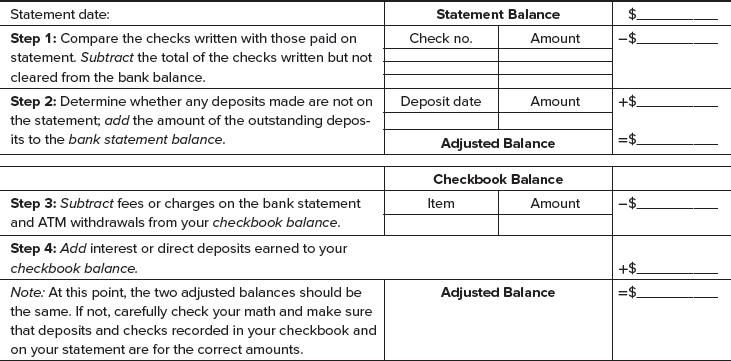
page 139


